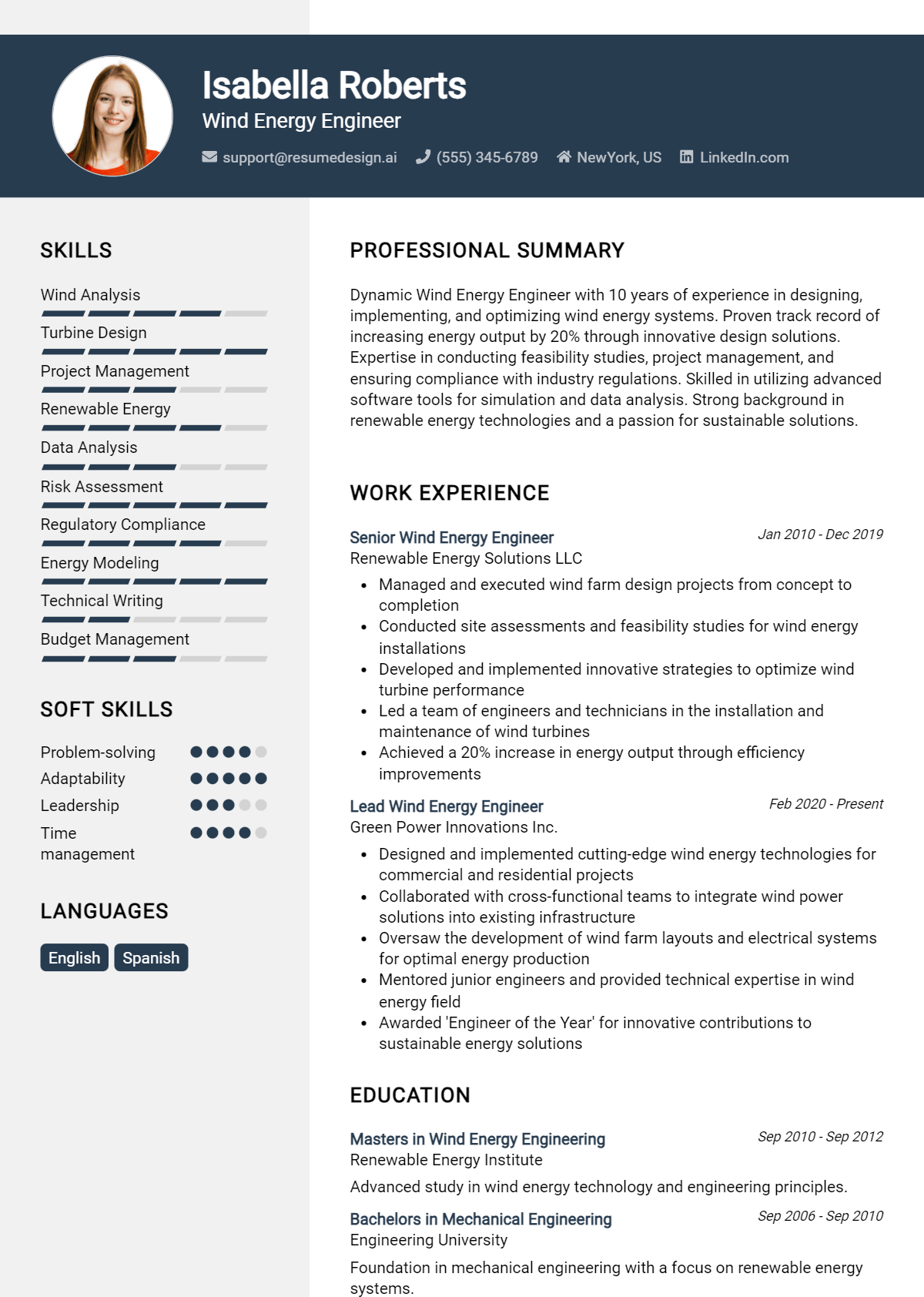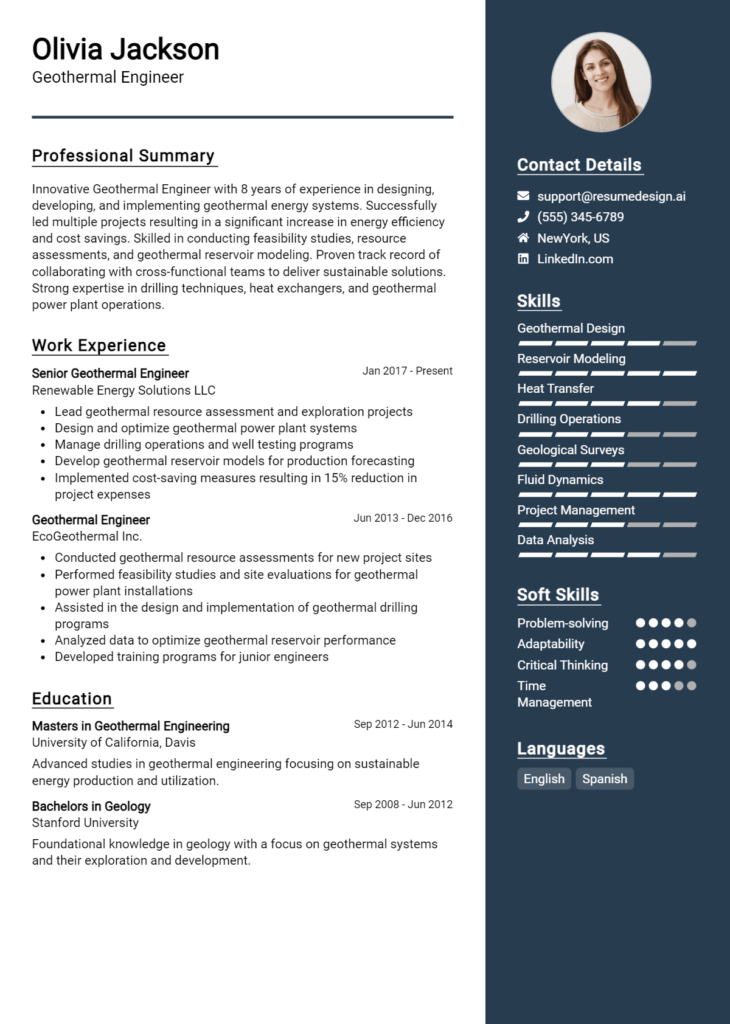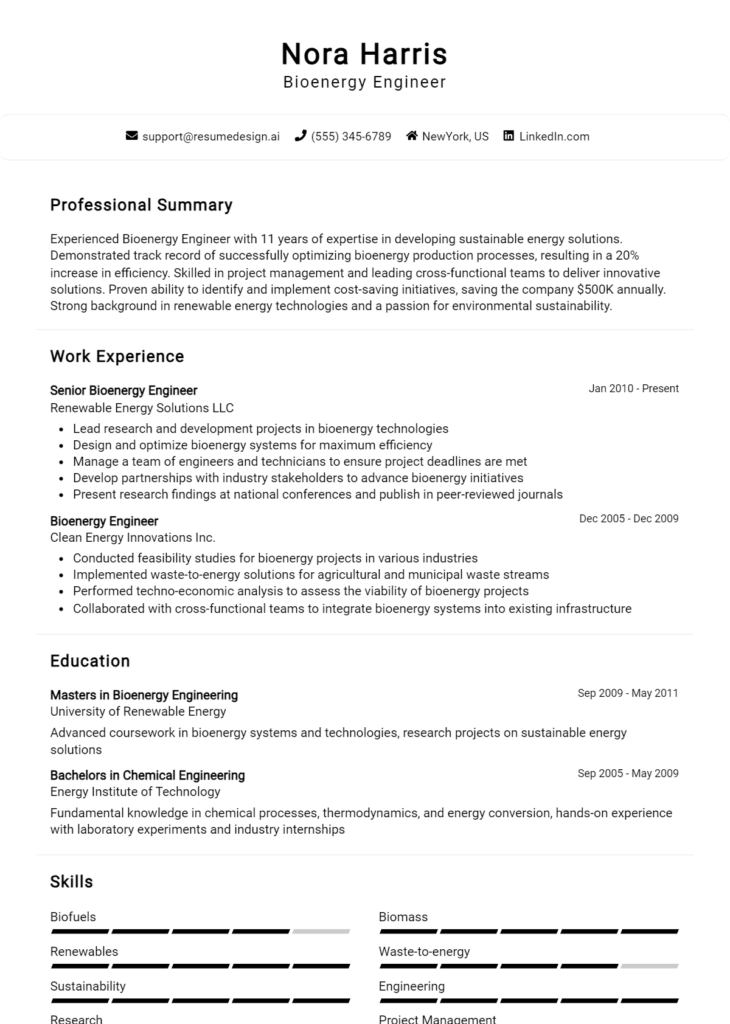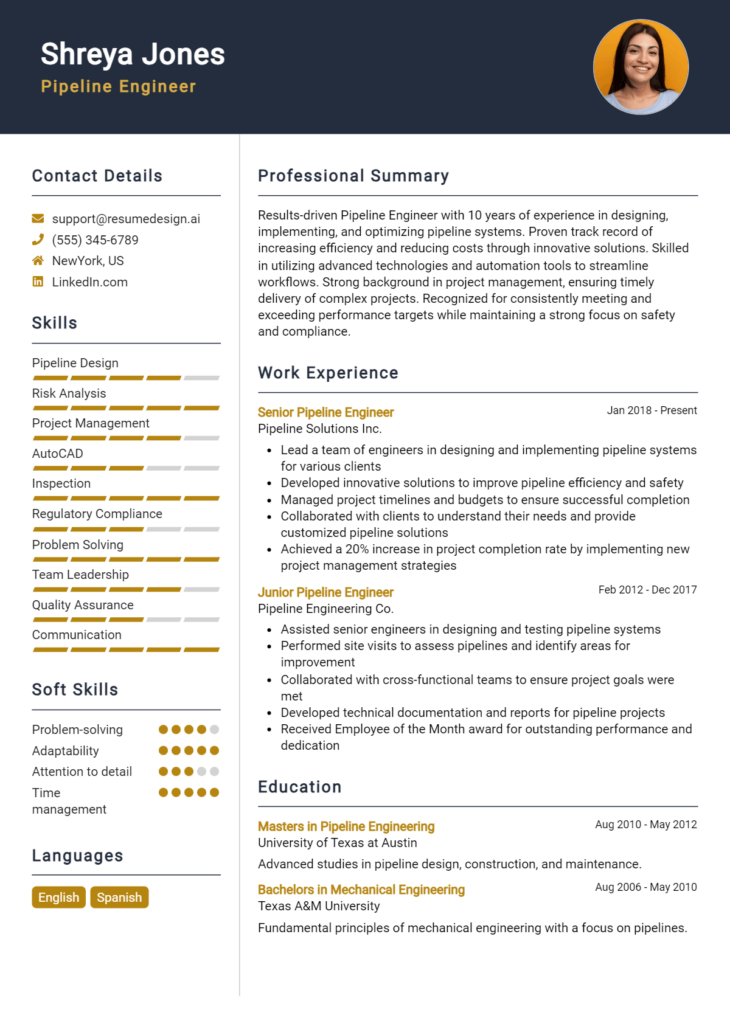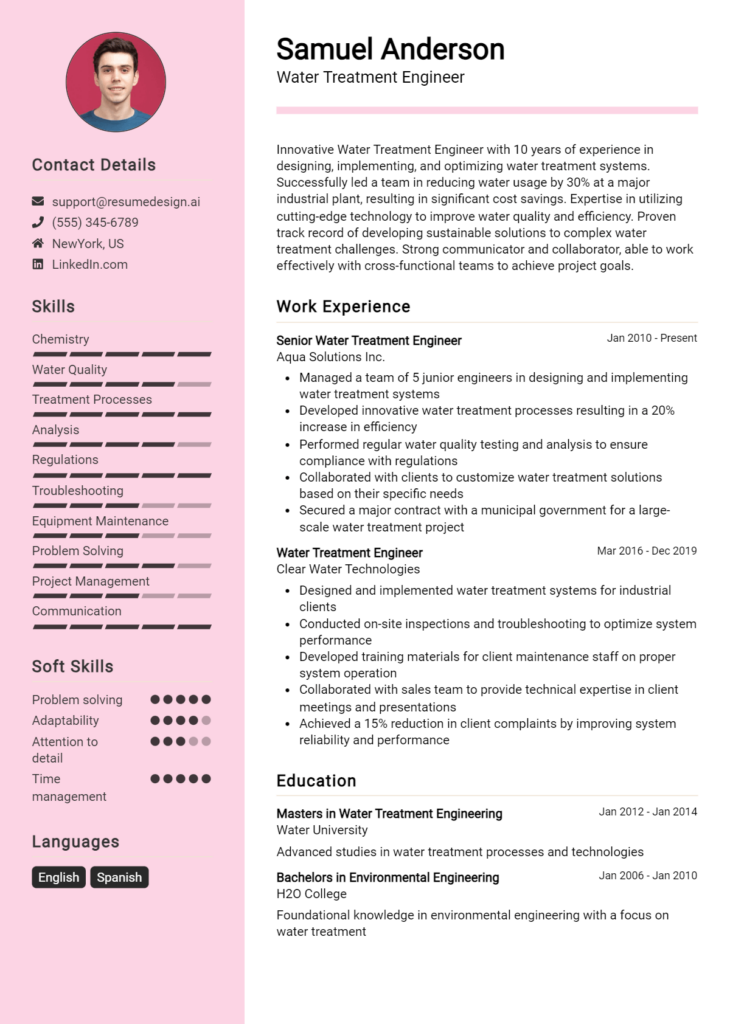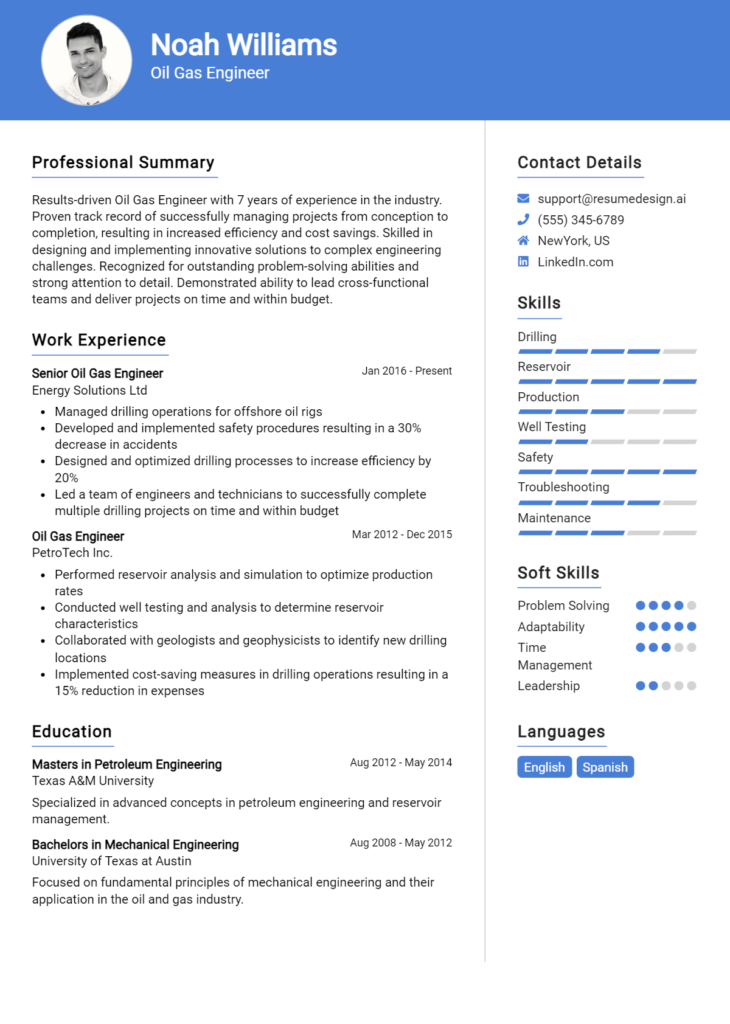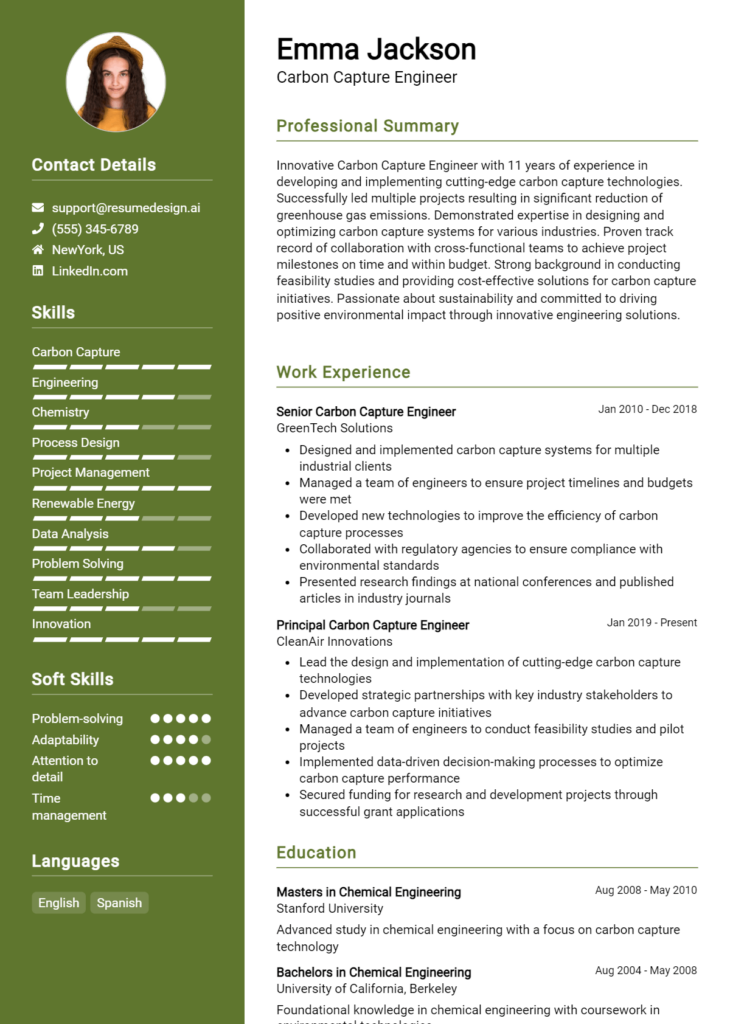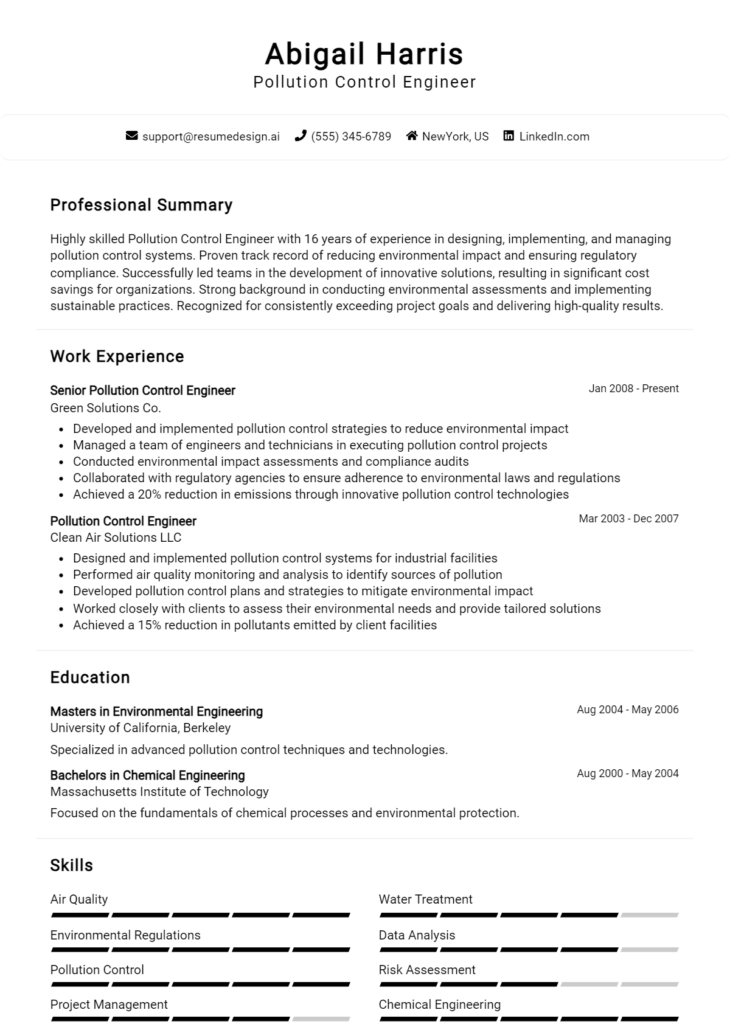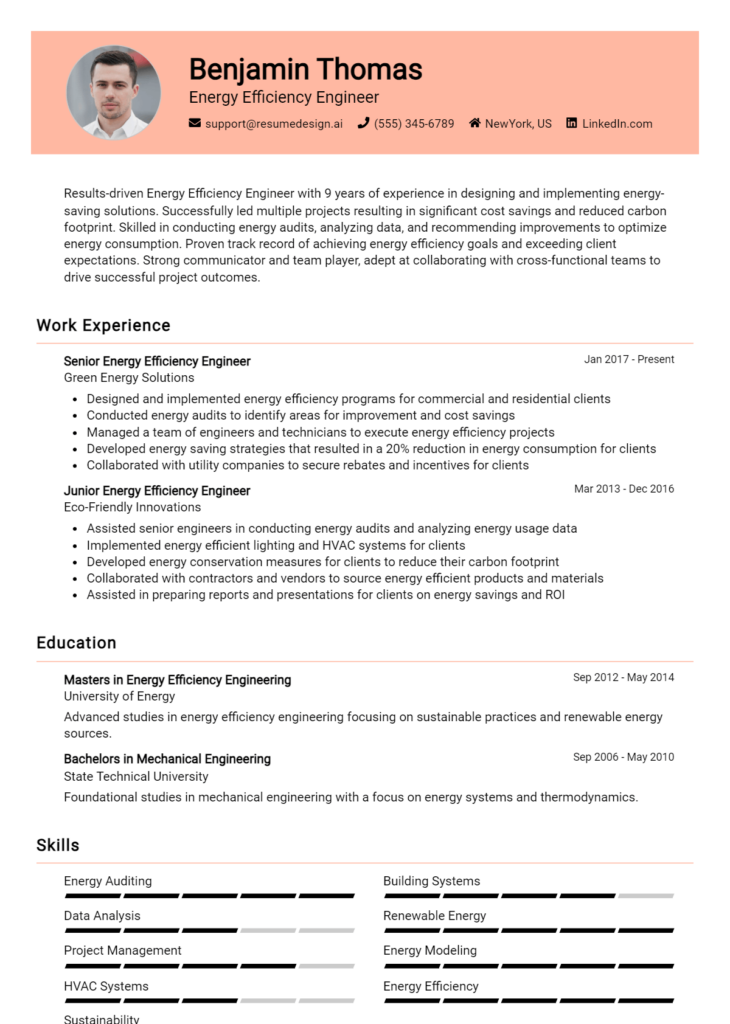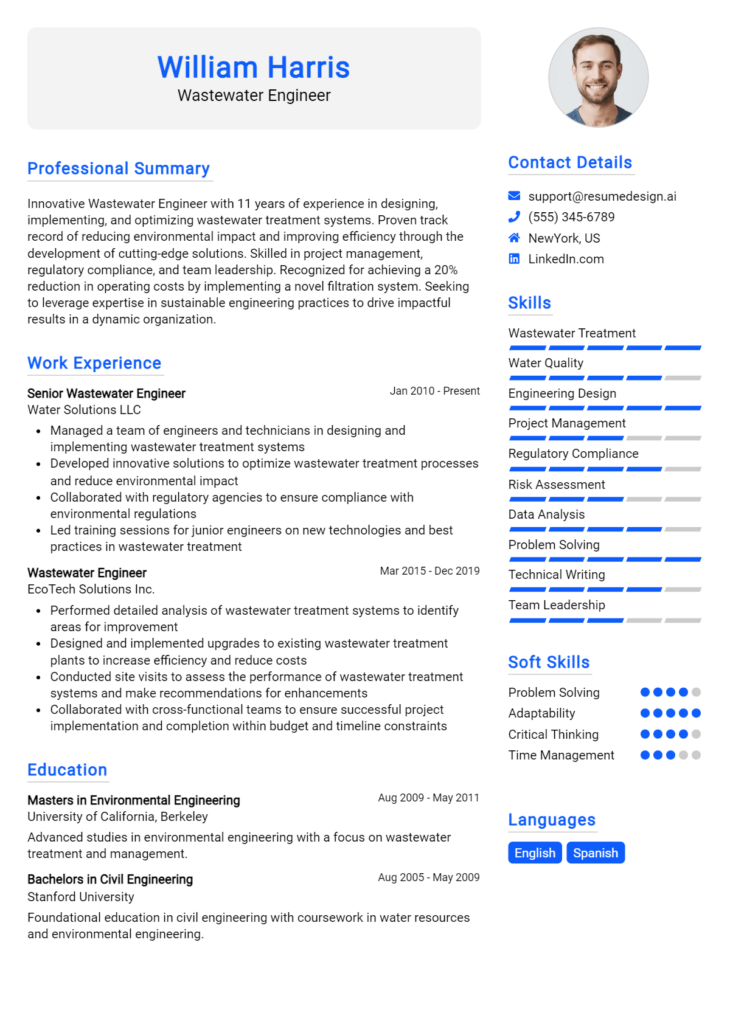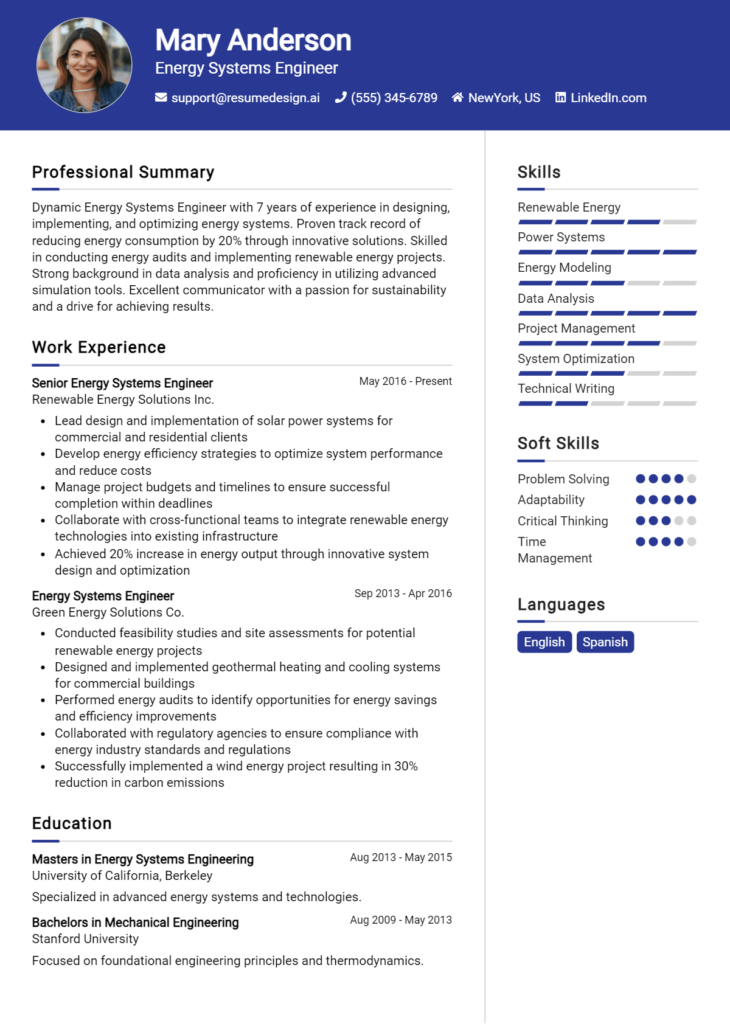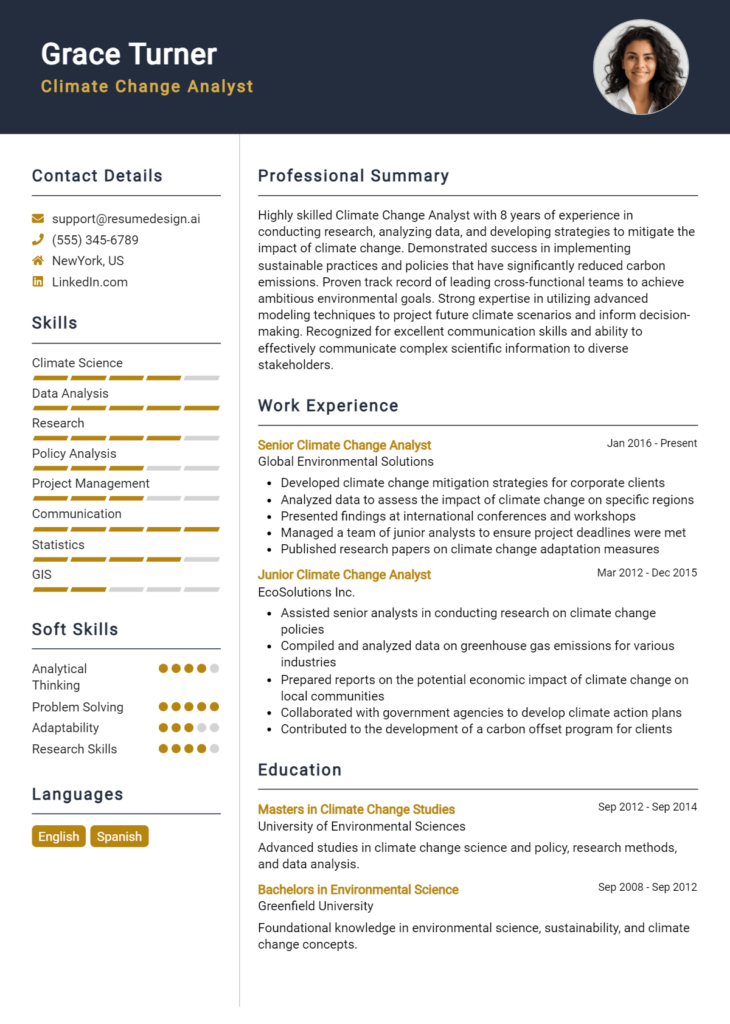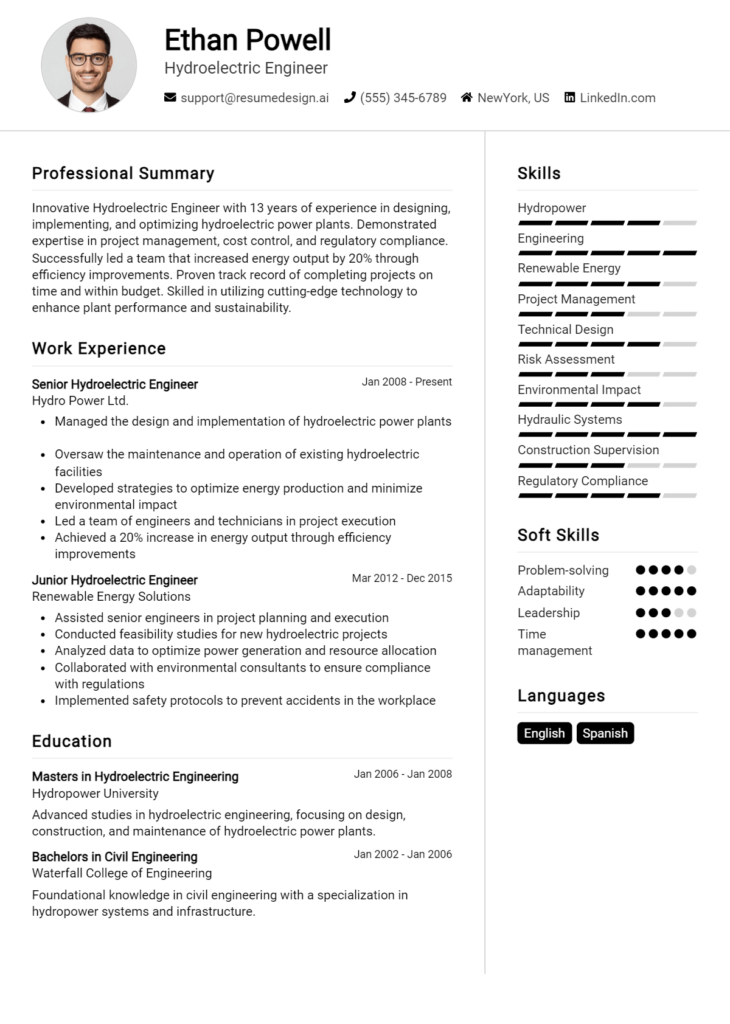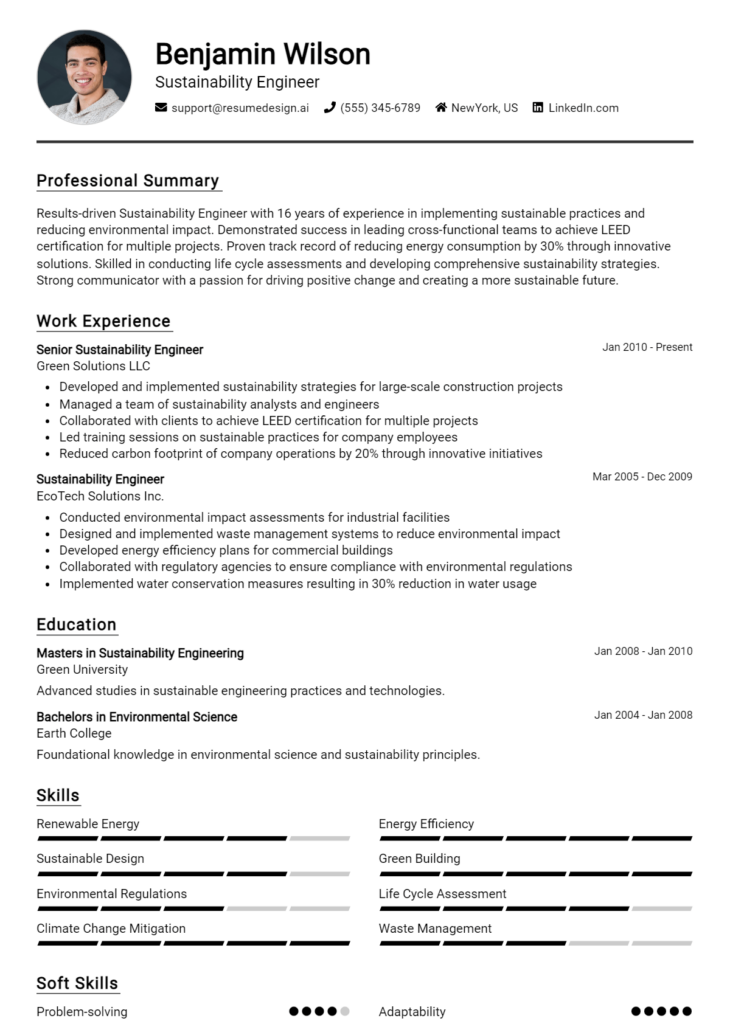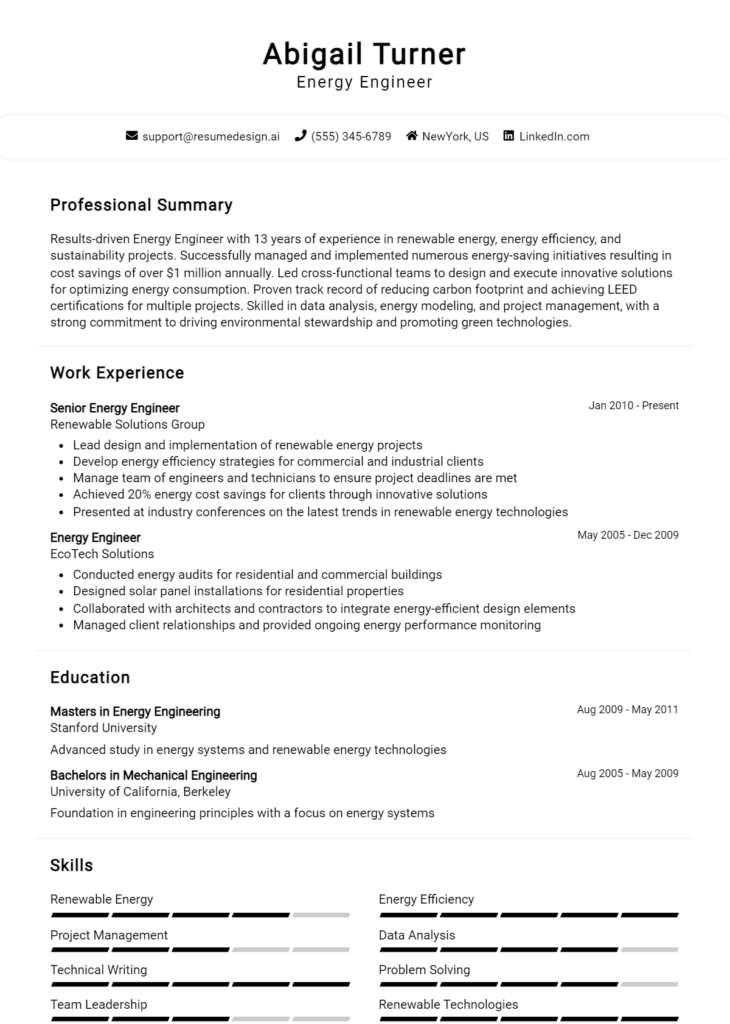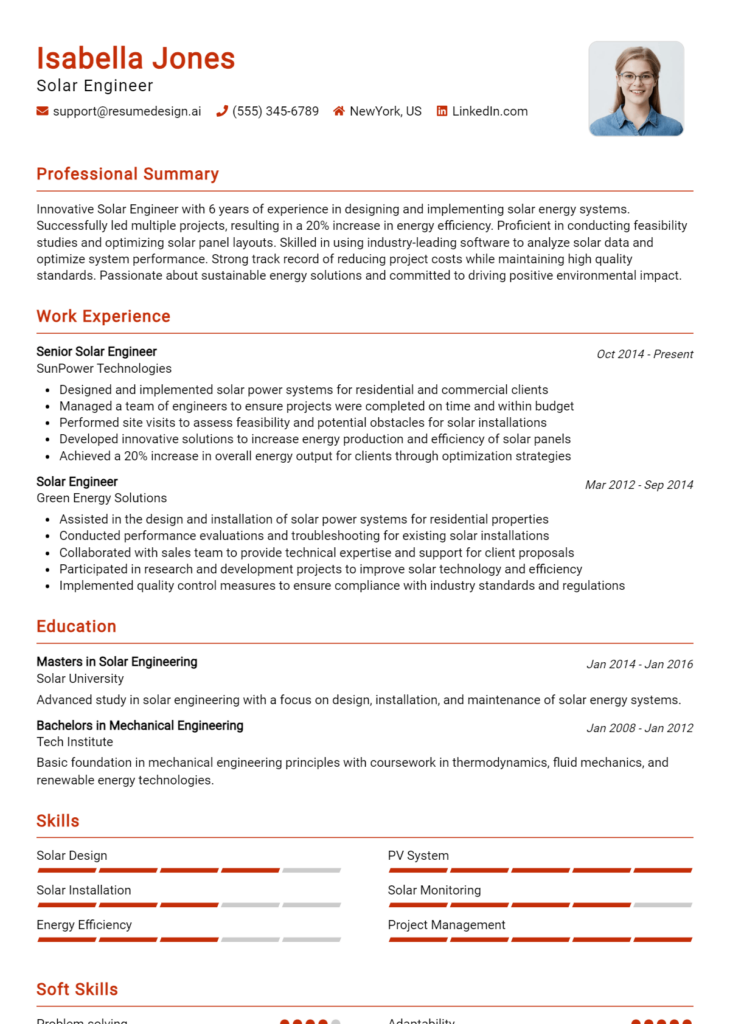Wind Energy Engineer Core Responsibilities
A Wind Energy Engineer plays a crucial role in the development and maintenance of wind energy projects, requiring a blend of technical, operational, and problem-solving skills. Responsibilities include designing wind turbine systems, conducting feasibility studies, and collaborating with various departments such as project management, environmental science, and compliance to ensure projects meet regulatory standards. Effective communication and analytical abilities are essential for troubleshooting and optimizing performance, directly contributing to the organization’s renewable energy goals. A well-structured resume highlighting these skills can significantly enhance career prospects.
Common Responsibilities Listed on Wind Energy Engineer Resume
- Design and analyze wind turbine systems and components.
- Conduct site assessments and feasibility studies for wind projects.
- Collaborate with multidisciplinary teams to integrate project plans.
- Perform technical evaluations and simulations for wind energy systems.
- Ensure compliance with environmental and safety regulations.
- Manage project timelines, budgets, and resource allocation.
- Conduct regular maintenance and performance evaluations of wind farms.
- Develop and implement innovative solutions to enhance energy output.
- Prepare technical reports and documentation for stakeholders.
- Stay updated on industry trends and technological advancements.
- Assist in grant writing and securing funding for projects.
- Provide training and support to operational staff regarding wind technologies.
High-Level Resume Tips for Wind Energy Engineer Professionals
In the competitive field of wind energy engineering, a well-crafted resume serves as a crucial tool for professionals looking to make their mark. As the first impression a candidate makes on a potential employer, a resume must effectively reflect not only technical skills and expertise but also a track record of achievements in the industry. It is essential for Wind Energy Engineer professionals to showcase their ability to contribute to sustainable energy solutions. This guide will provide practical and actionable resume tips tailored specifically for those seeking to advance their careers in wind energy engineering.
Top Resume Tips for Wind Energy Engineer Professionals
- Tailor your resume to the job description by incorporating keywords and phrases that align with the specific requirements and responsibilities outlined in the posting.
- Highlight relevant experience in wind energy projects, including design, implementation, and evaluation, ensuring that your contributions are clear and impactful.
- Quantify your achievements by including metrics such as energy output improvements, cost savings, or project completion times to demonstrate your effectiveness.
- Showcase industry-specific skills such as proficiency in wind turbine technology, environmental impact assessments, and renewable energy regulations.
- Include certifications and licenses related to wind energy, such as Certified Renewable Energy Professional (CREP) or Wind Turbine Technician credentials.
- Use action verbs to convey your accomplishments and responsibilities, making your experiences sound dynamic and engaging.
- Keep your resume concise and focused, ideally no longer than one page, to ensure that hiring managers can easily digest your qualifications.
- Incorporate a summary statement at the top of your resume that clearly articulates your career goals and the value you can bring to a prospective employer.
- Highlight any collaborative work with multidisciplinary teams, as wind energy projects often require cross-functional cooperation.
- Include any relevant professional development activities, such as workshops or conferences, that demonstrate your commitment to staying current in the field.
By implementing these tailored resume tips, Wind Energy Engineer professionals can significantly enhance their chances of standing out in the job market. A well-structured and focused resume not only showcases technical expertise but also emphasizes a candidate's unique contributions to the renewable energy sector, making them more appealing to potential employers.
Why Resume Headlines & Titles are Important for Wind Energy Engineer
In the competitive field of wind energy engineering, a well-crafted resume headline or title serves as a powerful tool to capture the attention of hiring managers. A strong headline can succinctly summarize a candidate's key qualifications and expertise, making a memorable first impression. It acts as a hook that draws the reader in, encouraging them to explore the rest of the resume. Given the specialized nature of the role, the headline should be concise, relevant, and directly related to the job being applied for, ensuring it reflects the candidate’s unique skills and experience in the wind energy sector.
Best Practices for Crafting Resume Headlines for Wind Energy Engineer
- Keep it concise—aim for one impactful phrase.
- Use relevant keywords specific to the wind energy industry.
- Highlight your most significant achievement or qualification.
- Ensure it aligns with the job description and requirements.
- Incorporate action verbs to convey a sense of proactivity.
- Avoid jargon that may not be understood outside the industry.
- Showcase your unique selling points or specialized skills.
- Make it engaging to evoke interest in your resume.
Example Resume Headlines for Wind Energy Engineer
Strong Resume Headlines
"Innovative Wind Energy Engineer with 10+ Years of Experience in Turbine Design"
“Certified Renewable Energy Specialist Focused on Wind Energy Solutions”
“Results-Driven Engineer with Proven Success in Wind Farm Project Management”
Weak Resume Headlines
“Engineer Looking for New Opportunities”
“Experienced Professional in Energy”
The strong headlines are effective because they are specific, showcasing the candidate’s expertise and experience in wind energy engineering, while directly addressing the skills that hiring managers value. In contrast, the weak headlines fail to impress due to their vagueness and lack of detail, leaving hiring managers with little incentive to delve deeper into the resume. A compelling headline sets the tone for the entire resume, making it essential for candidates to invest time in crafting a strong, tailored title that highlights their qualifications.
Writing an Exceptional Wind Energy Engineer Resume Summary
Crafting an exceptional resume summary is crucial for Wind Energy Engineers seeking to stand out in a competitive job market. A well-written summary serves as a powerful introduction, quickly capturing the attention of hiring managers by highlighting key skills, relevant experience, and notable accomplishments tailored to the specific role. This concise and impactful section not only sets the tone for the entire resume but also allows candidates to showcase their unique value proposition, making it easier for employers to see their potential contributions to the organization.
Best Practices for Writing a Wind Energy Engineer Resume Summary
- Quantify achievements to provide context and demonstrate impact.
- Focus on specific skills that are relevant to wind energy engineering.
- Tailor the summary for the job description to align with employer expectations.
- Use industry-specific terminology to show familiarity with the field.
- Keep it concise, ideally within 2-4 sentences.
- Highlight your unique selling points, such as certifications or advanced software skills.
- Incorporate keywords from the job posting to enhance visibility during applicant tracking.
- Showcase problem-solving abilities and innovative contributions to previous projects.
Example Wind Energy Engineer Resume Summaries
Strong Resume Summaries
Results-driven Wind Energy Engineer with over 5 years of experience in designing and optimizing wind turbine systems. Successfully led a project that increased energy output by 20% through innovative redesigns, contributing to a $1.5 million annual revenue boost.
Detail-oriented engineer specializing in wind energy technology, with expertise in aerodynamic modeling and structural analysis. Played a key role in the development of a new wind farm that generated 150 MW, exceeding performance expectations by 15%.
Dedicated Wind Energy Engineer with a Master's in Renewable Energy and a proven track record of reducing operational costs by 30% through effective maintenance strategies. Proficient in using simulation software to enhance turbine efficiency.
Innovative Wind Energy Engineer with extensive knowledge in project management and regulatory compliance, successfully overseeing the deployment of 50+ turbines across three major projects, resulting in a 40% increase in regional clean energy capacity.
Weak Resume Summaries
Experienced engineer looking for opportunities in wind energy. I have worked on various projects in the engineering field.
Wind Energy Engineer with skills in design and analysis. I am seeking a position where I can utilize my knowledge.
The strong resume summaries are considered effective because they provide specific achievements, measurable outcomes, and relevant skills tailored to the wind energy sector. They clearly demonstrate the candidate's impact on previous projects and highlight specialized knowledge. In contrast, the weak summaries lack detail and quantification, making them vague and less compelling. They fail to showcase distinct contributions or demonstrate a clear fit for the role, ultimately making them less appealing to hiring managers.
Work Experience Section for Wind Energy Engineer Resume
The work experience section of a Wind Energy Engineer resume is crucial as it serves as a platform for candidates to demonstrate their technical skills, project management capabilities, and ability to deliver high-quality outcomes. This section not only highlights the hands-on experience that candidates have in the field of wind energy but also showcases their proficiency in utilizing cutting-edge technologies and methodologies. By quantifying achievements and aligning their experiences with industry standards, candidates can effectively illustrate their impact in previous roles, making a strong case for their qualifications in this competitive field.
Best Practices for Wind Energy Engineer Work Experience
- Focus on quantifiable results: Use metrics to demonstrate the impact of your work, such as energy output increases or cost reductions.
- Highlight technical expertise: Specify the technologies, software, and methodologies you've used in your projects.
- Emphasize leadership and collaboration: Describe your experience in managing teams, coordinating with stakeholders, and leading projects.
- Align with industry standards: Use terminology and frameworks familiar to the wind energy sector to resonate with employers.
- Detail project scope: Clearly outline the scale and significance of the projects you have worked on.
- Incorporate relevant certifications: Mention any licenses or certifications that validate your skills in wind energy engineering.
- Showcase problem-solving skills: Provide examples of how you addressed challenges in previous projects and the solutions you implemented.
- Keep it concise and relevant: Tailor your work experience to focus on achievements that are most relevant to the position you are applying for.
Example Work Experiences for Wind Energy Engineer
Strong Experiences
- Led a cross-functional team to design and implement a wind farm that increased energy production by 30%, resulting in an annual revenue increase of $2 million.
- Developed and optimized turbine layout using advanced modeling software, enhancing overall efficiency by 15% and reducing operational costs by 10%.
- Managed a team of engineers in the successful completion of a $5 million wind project ahead of schedule, achieving a 95% client satisfaction rating.
- Conducted feasibility studies for multiple wind energy sites, leading to the selection of the optimal location for a new wind farm that reduced environmental impact by 20%.
Weak Experiences
- Worked on wind energy projects.
- Assisted in some technical tasks related to wind turbines.
- Participated in team meetings about project development.
- Helped with paperwork for wind farm projects.
The strong experiences listed demonstrate clear, quantifiable outcomes, showcasing the candidate's technical leadership and collaborative capabilities in impactful projects. In contrast, the weak experiences lack specificity and measurable results, failing to convey the candidate's true contributions and competencies in the field of wind energy engineering. This comparison highlights the importance of detailing accomplishments and skills to present a compelling case to potential employers.
Education and Certifications Section for Wind Energy Engineer Resume
The Education and Certifications section of a Wind Energy Engineer resume is pivotal in presenting the candidate's academic credentials and professional qualifications. This section serves to highlight not only the foundational knowledge acquired through formal education but also the industry-relevant certifications that demonstrate a commitment to continuous learning and professional development. By detailing relevant coursework, specialized training, and recognized certifications, candidates can significantly enhance their credibility and align themselves more closely with the specific demands of the wind energy sector. In a rapidly evolving field like renewable energy, showcasing an up-to-date educational background can set a candidate apart in a competitive job market.
Best Practices for Wind Energy Engineer Education and Certifications
- Include only relevant degrees and certifications that align with wind energy engineering.
- Clearly list your highest degree first, followed by additional qualifications in reverse chronological order.
- Highlight any specialized training or coursework directly related to wind energy systems, aerodynamics, or energy management.
- Incorporate industry-recognized certifications, such as the Certified Renewable Energy Professional (CREP) or Project Management Professional (PMP).
- Provide details about honors, awards, or relevant projects completed during your studies.
- Keep the section concise but informative; avoid unnecessary details that do not pertain to the wind energy field.
- Consider including a section for ongoing education, such as workshops or online courses related to advances in wind technology.
- Ensure that all credentials are up-to-date, reflecting any recent changes or renewals in certifications.
Example Education and Certifications for Wind Energy Engineer
Strong Examples
- B.S. in Renewable Energy Engineering, University of Wind Studies, 2021
- Certified Renewable Energy Professional (CREP), 2022
- Coursework in Wind Turbine Design, Energy Policy, and Aerodynamics
- M.S. in Environmental Engineering with a focus on Wind Energy Systems, Green Energy University, 2023
Weak Examples
- B.A. in History, State University, 2015
- Certification in Basic Computer Skills, 2018
- Completed a workshop on Traditional Energy Sources, 2020
- High School Diploma, 2010
The examples provided illustrate the distinction between strong and weak qualifications for a Wind Energy Engineer. Strong examples feature relevant degrees and certifications that directly relate to the wind energy field, showcasing a commitment to the profession and specialized knowledge. In contrast, weak examples highlight qualifications that are outdated or unrelated to the position, indicating a lack of focus on the necessary skills and knowledge essential for success in the wind energy sector.
Top Skills & Keywords for Wind Energy Engineer Resume
As a Wind Energy Engineer, showcasing the right skills on your resume is crucial for standing out in a competitive job market. Employers look for candidates who not only possess technical expertise but also demonstrate strong interpersonal and organizational abilities. By highlighting both hard and soft skills, you can present a well-rounded profile that reflects your capability to contribute effectively to wind energy projects. The right blend of skills in your resume can significantly enhance your chances of landing an interview and ultimately securing the job.
Top Hard & Soft Skills for Wind Energy Engineer
Soft Skills
- Problem-solving
- Communication
- Team collaboration
- Adaptability
- Project management
- Critical thinking
- Leadership
- Attention to detail
- Time management
- Creativity
Hard Skills
- Wind turbine design
- Fluid dynamics analysis
- Structural analysis
- Energy conversion technologies
- Computer-aided design (CAD)
- Geographic Information Systems (GIS)
- Data analysis and modeling
- Electrical systems knowledge
- Regulatory compliance
- Performance testing and optimization
Emphasizing these skills on your resume, along with relevant work experience, will help you convey your qualifications effectively to potential employers and demonstrate your readiness to excel in the field of wind energy engineering.
Stand Out with a Winning Wind Energy Engineer Cover Letter
Dear [Hiring Manager's Name],
I am writing to express my enthusiasm for the Wind Energy Engineer position at [Company Name], as advertised on [Job Board/Company Website]. With a solid background in renewable energy engineering, combined with hands-on experience in wind turbine design and implementation, I am excited about the opportunity to contribute to your team. My academic foundation in mechanical engineering, coupled with my passion for sustainable energy solutions, makes me a strong candidate for this role.
During my previous role at [Previous Company Name], I successfully led a team in the development of a wind farm project that increased our energy output by 30% while minimizing environmental impact. My responsibilities included conducting site assessments, designing turbine layouts, and collaborating with cross-functional teams to ensure compliance with industry standards. I am well-versed in the latest software and tools used for wind energy modeling and analysis, which I believe will allow me to hit the ground running at [Company Name]. Additionally, my ability to analyze complex data and present findings clearly has been instrumental in securing project approvals and stakeholder buy-in.
I am particularly drawn to [Company Name] because of your commitment to innovation and sustainability in the wind energy sector. I admire your recent projects, notably [specific project or initiative], and I am eager to bring my expertise in optimizing energy systems and improving operational efficiencies to your team. I am confident that my proactive approach and dedication to advancing renewable energy sources will be a valuable addition to your organization.
Thank you for considering my application. I look forward to the opportunity to discuss how my skills and experiences align with the goals of [Company Name]. I am excited about the possibility of contributing to your mission of driving the transition to a greener future through wind energy.
Sincerely,
[Your Name]
[Your Phone Number]
[Your Email Address]
Conclusion
As we conclude our discussion on the essential skills and responsibilities of a Wind Energy Engineer, it’s important to highlight the increasing demand for professionals in this field. With a focus on renewable energy solutions, Wind Energy Engineers play a crucial role in designing, developing, and implementing wind turbine systems. Key competencies include a solid understanding of electrical and mechanical engineering principles, proficiency in software tools for modeling and simulation, and the ability to conduct thorough site assessments.
Moreover, staying abreast of industry regulations and advancements in technology is vital for success in this rapidly evolving sector. Continuous professional development through certifications and training can also enhance your career prospects.
Now is the perfect time to review your Wind Energy Engineer resume to ensure it effectively showcases your skills and experiences. Utilize available resources to strengthen your application. Explore resume templates to find a layout that suits your professional style. If you prefer a more hands-on approach, try the resume builder for a customized experience. Additionally, browse through resume examples to gather inspiration and see how others in your field present their qualifications. And don’t forget to check out cover letter templates to complement your resume and make a compelling case for your candidacy.
Take action today to enhance your resume and position yourself as a strong contender in the growing wind energy industry!

